我要做花色素的定性实验,用液相色谱。买的色素标样是粉末的,要怎么配制成储备液,用什么配制呢?我的色素是芍药花素,矢车菊素和天竺葵素。
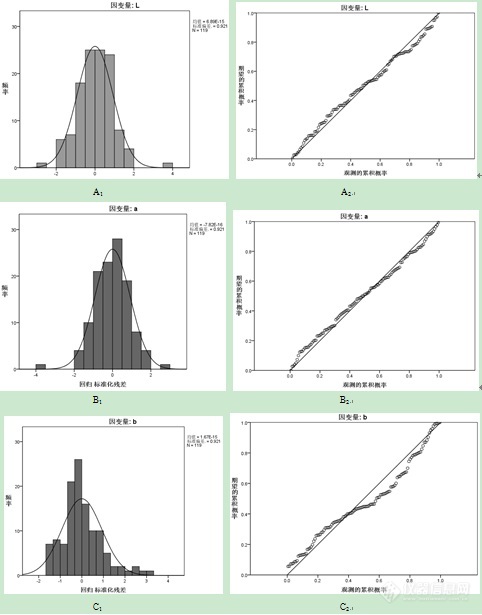
红葡萄酒CIELAB参数与花色素的主成分多元线性回归分析 摘 要:采用CIELAB色空间体系对119 种市售红葡萄酒颜色参数进行分析,并利用超高效液相色谱串联二级质谱法、pH示差法分析测定红葡萄酒样品中16 种单体花色素含量、总花色素含量,使用主成分分析、相关性分析和多元线性回归分析法对上述变量因子进行分析,研究红葡萄酒CIELAB体系中L*值、a*值和b*值与单体花色素、总花色素含量、pH值之间关系。结果表明,通过主成分分析得到对红葡萄酒颜色贡献程度较大的3 种主成分,累计贡献率达到84.11%。CIELAB色空间体系的颜色参数分别受不同单体花色素含量影响,对L*值、a*值影响最大的单体花色素为矢车菊素-3-O-葡萄糖苷,对b*值影响最大的单体花色素为锦葵色素,总花色素含量对L*值、a*、b*值均有显著影响,L*值与a*值关系呈极显著负相关。关键词:CIELAB色空间;花色素;相关性分析;主成分分析;多元线性回归分析 颜色是反映葡萄酒品质的重要属性,可以提供葡萄酒类型、陈酿时间等相关信息,会对消费者的选择和认知产生影响。研究红葡萄酒中花色素及葡萄酒颜色参数之间的联系,对影响葡萄酒呈色的化学成分及原因进行理论分析,可以为红葡萄酒酿制的工艺优化、品质分析、质量控制及其他相关基础研究提供一定理论依据。花色素是产生葡萄酒颜色变化的基础物质,其含量和结构稳定性对葡萄酒感官品质具有重要影响。近年来,国内外学者从不同角度对葡萄酒中花色素及其与葡萄酒颜色之间的关系进行了研究。张波等论述了红葡萄酒中主要花色素以及衍生物的结构特征、形成途径和理化性质,并对葡萄酒中花色素辅色化作用等进行了系统介绍。梁娜娜等分析了6 种葡萄酒中花色素含量与葡萄酒颜色参数间的关系,发现不同花色素对不同葡萄酒颜色参数具有一定影响。兰圆圆等对21 款不同品种和年份的干红葡萄酒进行分析,研究了总花色素、总酚含量和颜色参数之间的联系,发现总花色素含量与葡萄酒颜色深度等颜色参数具有显著相关性。葛谦等分析了葡萄酒酿造过程中6 种花色素单体、花色素含量与葡萄酒颜色参数的变化规律。Sáenz-Navajas等研究分析了西班牙58 份市售橡木红葡萄酒样本中花色素组成与颜色参数之间的联系。目前国际上进行颜色评价的方法体系主要有RGB色空间、孟塞尔色彩体系、CIELUV色空间和CIELAB色空间。其中只有CIELAB色空间与人眼色刺激值感官相符,被广泛应用于食品及葡萄酒的相关研究。我国国家质检总局认定的《感官分析 食品颜色评价的总则和检验方法》和《均匀色空间和色差公式》中均使用该体系进行颜色评价。本研究采集119 种红葡萄酒为供试样品,对其CIELAB颜色参数、16 种常见单体花色素含量及总花色素含量进行大样本检测分析,通过主成分分析、相关分析及多元线性回归分析寻找参数间相关联系,以期为进一步有针对性开展红葡萄酒辅色研究及品质优化提供一定参考依据。 1 材料与方法 1.1 材料与试剂市售119 种红葡萄酒。乙腈(色谱纯) 美国Fisher公司;浓盐酸、冰醋酸(均为分析纯) `天津市凯通化学试剂有限公司;乙酸钠、氯化钾(均为分析纯) 天津市光复科技发展有限公司;花色素标准品(纯度≥99.5%):飞燕草色素(delphinidin,Del)、飞燕草素-3-葡萄糖苷(delphinidin-3-glucoside[co
原花青素和原花色素的具体区别?谢谢大家喽!
目前我正在用[url=https://insevent.instrument.com.cn/t/Yp][color=#3333ff]液质联用[/color][/url]技术做花色素的定性分析,包括花青素和类黄酮,目前实验已经完成,但是分析的时候因为没有花青素和类黄酮的一级、二级质荷比数据,因此只能一篇篇的查文献,导师催的紧,很着急,因此来求助,请问大家有没有整理好的比较全的花青素和类黄酮的一级、二级质荷比数据资料,我可以直接用的。

[align=center][b][font='times new roman'][size=18px]红花[/size][/font][font='times new roman'][size=18px]中[/size][/font][font='times new roman'][size=18px]羟基红花黄色素[/size][/font][font='times new roman'][size=18px]A[/size][/font][font='times new roman'][size=18px]和山奈[/size][/font][font='times new roman'][size=18px]酚[/size][/font][font='times new roman'][size=18px]测定[/size][/font][/b][/align][align=center][img]https://ng1.17img.cn/bbsfiles/images/2022/11/202211231824251465_793_1858223_3.jpeg[/img][/align][align=center][/align][font='times new roman']1 [/font][font='times new roman']材料与试剂[/font][font='times new roman']乙腈[/font][font='times new roman']、甲醇[/font][font='times new roman'](色谱级)、[/font][font='times new roman']甲醇、[/font][font='times new roman']盐酸、[/font][font='times new roman']磷酸[/font][font='times new roman'](分析纯)、[/font][font='times new roman']羟基红花黄色素[/font][font='times new roman']A[/font][font='times new roman']和山奈[/font][font='times new roman']酚[/font][font='times new roman'](购自中检院)、[/font][font='times new roman']红花[/font][font='times new roman']样品[/font][font='times new roman'](客户送检)[/font][font='times new roman']。[/font][font='times new roman']2 [/font][font='times new roman']色谱条件[/font][font='times new roman']LC-20AT[/font][font='times new roman'][url=https://insevent.instrument.com.cn/t/5p][color=#3333ff]液相色谱仪[/color][/url](日本岛津),色谱柱:[/font][font='times new roman']Zorbax[/font][font='times new roman'] [/font][font='times new roman']E[/font][font='times new roman']clipse[/font][font='times new roman'] XDB-[/font][font='times new roman'] [/font][font='times new roman']C18(250mm*4.6μm*5μm)[/font][font='times new roman'](安捷伦),[/font][font='times new roman'] [/font][font='times new roman']羟基红花黄色素[/font][font='times new roman']A[/font][font='times new roman']:[/font][font='times new roman']以甲醇[/font][font='times new roman']-[/font][font='times new roman']乙腈[/font][font='times new roman']-0.7%[/font][font='times new roman']磷酸溶液([/font][font='times new roman']26[/font][font='times new roman']:[/font][font='times new roman']2[/font][font='times new roman']:[/font][font='times new roman']72[/font][font='times new roman'])为流动相[/font][font='times new roman'],[/font][font='times new roman']柱温[/font][font='times new roman']3[/font][font='times new roman']5[/font][font='times new roman'] ℃[/font][font='times new roman'],[/font][font='times new roman']检测波长为[/font][font='times new roman']403nm[/font][font='times new roman'];[/font][font='times new roman']山奈[/font][font='times new roman']酚[/font][font='times new roman']:[/font][font='times new roman']以[/font][font='times new roman']甲醇[/font][font='times new roman']-[/font][font='times new roman']0.[/font][font='times new roman']4[/font][font='times new roman']%[/font][font='times new roman']磷酸水[/font][font='times new roman']梯度洗脱[/font][font='times new roman'];[/font][font='times new roman']柱温[/font][font='times new roman']3[/font][font='times new roman']5[/font][font='times new roman'] [/font][font='times new roman']℃[/font][font='times new roman']。[/font][font='times new roman']检测波长为[/font][font='times new roman']3[/font][font='times new roman']67[/font][font='times new roman']nm[/font][font='times new roman'],[/font][font='times new roman']3[/font][font='times new roman']溶液制备[/font][font='times new roman'](按照中国药典[/font][font='times new roman']2[/font][font='times new roman']020[/font][font='times new roman']年版一部[/font][font='times new roman']红花[/font][font='times new roman']项下测定)[/font][font='times new roman']3[/font][font='times new roman'].1[/font][font='times new roman']红花中羟基红花素[/font][font='times new roman']测定[/font][font='times new roman']对照品溶液的制备[/font][font='times new roman'] [/font][font='times new roman']取羟基红花黄色素[/font][font='times new roman']A[/font][font='times new roman']对照品适量,精密称定,加[/font][font='times new roman']25%[/font][font='times new roman']甲醇制成每[/font][font='times new roman']1m[/font][font='times new roman']L[/font][font='times new roman']含[/font][font='times new roman']0.1[/font][font='times new roman']4 [/font][font='times new roman']mg[/font][font='times new roman']的溶液,即得。[/font][font='times new roman'] [/font][align=center][font='times new roman'][img=,690,166]https://ng1.17img.cn/bbsfiles/images/2022/11/202211231826389211_7857_1858223_3.jpg!w690x166.jpg[/img] [/font][font='times new roman']羟基红花黄色素[/font][font='times new roman']A[/font][font='times new roman']对照品[/font][font='times new roman']色谱图[/font][/align][font='times new roman']样品[/font][font='times new roman']溶液的制备[/font][font='times new roman'] [/font][font='times new roman']取本品粉末(过三号筛)约[/font][font='times new roman']0.4g[/font][font='times new roman'],精密称定,[/font][font='times new roman']置具塞[/font][font='times new roman']锥形瓶中,精密加入[/font][font='times new roman']25%[/font][font='times new roman']甲醇[/font][font='times new roman']50m[/font][font='times new roman']L[/font][font='times new roman'],称定重量,超声处理(功率[/font][font='times new roman']300W[/font][font='times new roman'],频率[/font][font='times new roman']50kHz[/font][font='times new roman'])[/font][font='times new roman']40[/font][font='times new roman']分[/font][font='times new roman']钟,放冷,再称定重量,用[/font][font='times new roman']25%[/font][font='times new roman']甲醇[/font][font='times new roman']补足减失的[/font][font='times new roman']重量,摇匀,滤过,[/font][font='times new roman']取续滤液[/font][font='times new roman'],即得。 [/font][img]" style="max-width: 100% max-height: 100% [/img][align=center][img=,690,140]https://ng1.17img.cn/bbsfiles/images/2022/11/202211231827015873_9300_1858223_3.jpg!w690x140.jpg[/img][/align][align=center]红花药材中羟基红花素A测定色谱图[/align][font='times new roman']3.1[/font][font='times new roman']红花中[/font][font='times new roman']山奈[/font][font='times new roman']酚[/font][font='times new roman']测定[/font][font='times new roman']对照品溶液的制备[/font][font='times new roman'] [/font][font='times new roman']取山柰酚对照品适量,精密称定,加甲醇制成每[/font][font='times new roman']1ml[/font][font='times new roman']含[/font][font='times new roman']10 [/font][font='times new roman']μ[/font][font='times new roman']g[/font][font='times new roman']的溶液,即得。[/font][align=center][img=,690,131]https://ng1.17img.cn/bbsfiles/images/2022/11/202211231827143326_3128_1858223_3.jpg!w690x131.jpg[/img][/align][img]" style="max-width: 100% max-height: 100% [/img][align=center]山柰酚标品[/align][font='times new roman'] [/font][font='times new roman']样品[/font][font='times new roman']溶液的制备[/font][font='times new roman'] [/font][font='times new roman']取本品粉末(过三号筛)约[/font][font='times new roman']0.5g[/font][font='times new roman'],精密称定,[/font][font='times new roman']置具塞[/font][font='times new roman']锥形瓶中,精密加入甲醇[/font][font='times new roman']25m[/font][font='times new roman']L[/font][font='times new roman'],称定重量,加热回流[/font][font='times new roman']30[/font][font='times new roman']分钟,放冷,再称定重量,用甲醇[/font][font='times new roman']补足减失的[/font][font='times new roman']重量,摇匀,滤过,精密[/font][font='times new roman']量取续滤液[/font][font='times new roman']15m[/font][font='times new roman']L[/font][font='times new roman'],置平底烧瓶中,加盐酸溶液([/font][font='times new roman']15[/font][font='times new roman']→[/font][font='times new roman']37[/font][font='times new roman'])[/font][font='times new roman']5m[/font][font='times new roman']L[/font][font='times new roman'],摇匀,置水浴中加热水解[/font][font='times new roman']30[/font][font='times new roman']分钟,立即冷却,转移至[/font][font='times new roman']25m[/font][font='times new roman']L[/font][font='times new roman']量瓶中,用甲醇稀释至刻度,摇匀,滤过,[/font][font='times new roman']取续滤液[/font][font='times new roman'],即得[/font][align=center][img=,690,138]https://ng1.17img.cn/bbsfiles/images/2022/11/202211231827289628_6371_1858223_3.jpg!w690x138.jpg[/img][/align][img]" style="max-width: 100% max-height: 100% [/img][align=center]红花中山柰酚测定[/align][font='times new roman']结果:客户送检样品[/font][font='times new roman']红花[/font]中羟基红花素A含量为1.7%,山奈酚含量为0.065%[font='times new roman']。[/font][font='times new roman']注:[/font][font='times new roman']①[/font][font='times new roman']测定[/font][font='times new roman']红花药材中羟基红花素[/font][font='times new roman']A[/font][font='times new roman']时流动相为三相,如果[url=https://insevent.instrument.com.cn/t/5p][color=#3333ff]液相色谱仪[/color][/url]为两通道建议混匀到一个流动相试剂瓶里进行测定。[/font][font='times new roman']②测定山奈酚时,需要用盐酸水解,加入盐酸后一定注意密塞,因为盐酸水浴容易挥发,影响水解效果。[/font]
需要购买原儿茶醛 红花苷 Crocin 红花素 羟基红花黄色素C 羟基红花黄色素K 丹酚酸B 10羟基-a-葵烯酸,请问哪里有卖?
如何去除西红花色素我现在做一个混合中药的薄层色谱,是用甲醇溶的,但是西红花有干扰!想请教一下:如何去除西红花色素,而把其他有效成分留住呢?
如何去除西红花色素我现在做一个混合中药的薄层色谱,是用甲醇溶的,但是西红花有干扰!想请教一下:如何去除西红花色素,而把其他有效成分留住呢?
植物色素(phytochromes)在植物中广泛分布,有脂溶性色素与水溶性色素两类。脂溶性色素多为四萜类衍生物,这类色素不溶于水,难溶于甲醇,易溶于乙醇、乙醚和氯仿等溶剂。常见的脂溶性植物色素有叶绿素、叶黄素、胡萝卜素、番红花素和辣椒红素等。其中胡萝卜素不溶于乙醇。有些色素有一定的生物活性,如叶绿素有一定的抑菌作用。 水溶性色素主要为花色甙类,又称花青素,普遍存在于花中。可溶于水与乙醇,不溶于乙醚与氯仿等有机溶剂,其色泽随pH的不同而改变。医学教.育网搜集整理 植物色素类常作为杂质除去,如在制备生物制剂或提取有效成分时加水稀释而使叶绿素析出,水溶性色素可用醋酸铅试剂沉淀或活性炭吸附除去。随着科学研究的深入,已发现不少色素具药用价值,如紫草的萘醌类色素能抑菌,红花中的红花红素与红花黄素能活血化瘀与抗氧化,姜黄中的姜黄素(curcumin)能降血脂和抑菌,栀子中的栀子黄色素(gardenin)能抑菌。
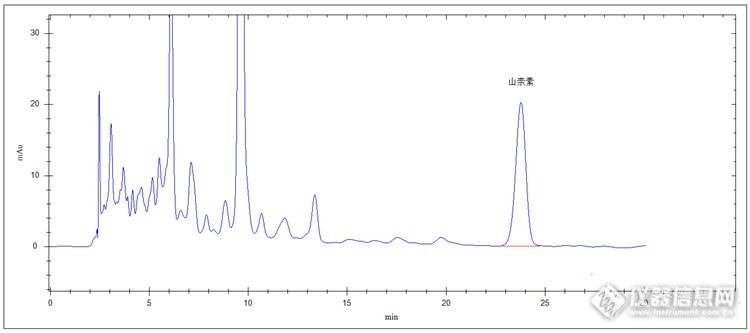
中药材红花高效液相色谱法检测 中药材红花为菊科植物红花的干燥花,夏季花由黄变红时采摘,阴干或晒干。 该药品具有活血通经、去瘀止痛、消肿润燥。用于治疗经闭、痛经、恶露不行、痈肿止痛、胸痹心痛、瘀滞腹痛,胸胁刺痛、跌打损伤、疮疡癥瘕、肌肉劳损、冠心病及多种妇科病等。 红花是生产多种药品的原材料,主要药物成分要严格控制。下面我们就采用高效液相色谱法对红花药材中重要成分羟基红花黄色素A和山柰素进行检测。 首先介绍下羟基红花黄色素A的检测。 对照品溶液制备:精密称取羟基红花黄色素A对照品5mg于50ml容量瓶中,加25%甲醇至刻度,配制成每0.1mg/ml羟基红花黄色素A对照品溶液,备用。 供试品溶液制备:取红花药材适量,充分粉碎后过三号筛(药典筛),精密称取过筛后粉末0.5g,置于具塞锥形瓶中,精密加入25%甲醇50ml,称定重量,超声处理40分钟,放冷,再次称定重量,用25%甲醇补足减少的重量,摇匀,0.45um有机相微膜滤过,待测。[/s

HPLC法测定桃红四物汤中苦杏仁苷和红花黄色素的含量摘 要 目的:测定桃红四物汤水提液中苦杏仁苷和红花黄色素含量。方法:采用高效液相色谱法(HPLC)测定桃红四物汤中苦杏仁苷和红花黄色素含量。苦杏仁苷色谱条件:流动相:甲醇-水(27∶73) ;色谱柱Hypersil BDS C18(4.6mm×200mm, 5µm),柱温25 ℃,检测波长218 nm;红花黄色素色谱条件:流动相:甲醇-0.1%磷酸水溶液(20∶80),色谱柱Hypersil BDS C18(4.6mm×200mm, 5µm),柱温25℃,检测波长:403nm。流速均为1.0mL·min-1,进样量均为:20μL。结果:苦杏仁苷在0.0822~1.315mg·mL-1范围内线性关系很好( r = 0.9998 ),平均回收率为98. 87 %,RSD为1.2%;红花黄色素在2.34×10-2~7.50×10-1 mg·mL-1范围内线性关系良好(r=0.9805),平均回收率为99.20%,RSD为0.88%。结论:本法简单快捷,重现性好,可作为桃红四物汤中苦杏仁苷和红花黄色素的质控方法。关键词:桃红四物汤;苦杏仁苷;红花黄色素;高效液相色谱法ABSTRACT Objective:To determine amygdalin and safflor yellow(SY)in Taohong Siwu Decoction.Methods:amygdalin was analyzed by HPLC on a Hypersil BDS C18 column (4.6mm×200mm, 5µm),[/color
食品中的着色剂 Colorants in Foods食用色素是指本来存在于食物或添加剂中的发色物质。 食用色素分天然食用色素和合成食用色素,天然食用色素是指天然食物中的色素物质,由于其对光、热、酸、碱等敏感,所以在加工、贮存过程中很容易褪色和变色,影响了其感官性能。因此在食品中有时添加合成色素。 色素的分类①来源:天然色素和人工合成色素;动物色素(红血素、虾青素等)、植物色素(叶绿素、胡箩卜素、花青素等)、微生物色素(红曲色素);②溶解性:脂溶性和水溶性;③结构:吡咯类色素(叶绿素、红血素等)、多烯类(类胡箩卜素)、酚类(花青素、儿茶素、花黄素等)、醌酮类(红曲色素、姜黄素、虫胶色素等)、其他。合成色素的特点: 色泽鲜艳、色调多、性能稳定、着色力强、坚牢度大、调色易、使用方便成本低廉、应用广泛用量和使用范围受到严格限制 天然色素的特点: 在色素含量和稳定性等方面不如合成色素因多来自水果、蔬菜和动植物,因而对人体的安全性较高能更好地模仿天然物的颜色,色调较自然成本较高保质期短天然色素直接来自动植物,除藤黄外,其余对人体无毒害。但国家对每一种天然食用色素也都规定了最大使用量,以策安全。目前允许使用的天然色素有姜黄、红花黄色素、辣椒红色素、虫胶色素、红曲米、酱色、甜菜红、叶绿素铜钠盐和β—胡萝卜素。天然色素安全上优于合成色素并可使用于所有食品种类。因此认为,为了给食品添加色素,最好选用天然色素,即使成本提高,消费者还是乐意接受的。
用于硬糖、果胶、琼脂、布丁、马希马洛糖、饼干、松蛋糕、蛋糕预制粉、稀奶油、冰淇淋、乳制品、蔬菜、青豆等罐头、饮料、果汁等的着色,为蓝色着色剂。在食品加工中直接着色不多,主要用于与天然的黄色素如栀子黄色素、红花黄色素等配伍,调配出不同色泽的绿色素,与提取的叶绿素相比,用栀子蓝色素调配的绿色素色调可以控制、耐酸性好,可用于偏酸性的食品、饮料中。另外栀子蓝色素还可与各种天然的红色素配伍,调配出不同色调的紫色。因此栀子蓝色素在食品加工中有较广阔的应用范围。栀子蓝色素因加工工艺的不同,可获得不同色调的蓝色素,颜色从天蓝色到海蓝色,还有耐酸性和不耐酸的品种,适合于不同的应用环境。天然的蓝色素自然界中是很少有的,栀子蓝色素是其中的一种,与合成色素食用亮蓝、靛蓝相比,其来源天然、人体相容性好,安全性高。是一种值得大力推广的天然色素。栀子蓝色素在食品、饮料、化妆品中的添加成本并不高,使用量为0.005%-0.01%之间,折算为单位成本约为0.025-0.05元/kg,当然与合成色素相比还是要高一些,合成色素在食品加工中的单位成本几乎为零,正是因为价格便宜,合成色素在食品上有滥用、超量使用的现象,这对人们的健康是不利的。
用于硬糖、果胶、琼脂、布丁、马希马洛糖、饼干、松蛋糕、蛋糕预制粉、稀奶油、冰淇淋、乳制品、蔬菜、青豆等罐头、饮料、果汁等的着色,为蓝色着色剂。在食品加工中直接着色不多,主要用于与天然的黄色素如栀子黄色素、红花黄色素等配伍,调配出不同色泽的绿色素,与提取的叶绿素相比,用栀子蓝色素调配的绿色素色调可以控制、耐酸性好,可用于偏酸性的食品、饮料中。另外栀子蓝色素还可与各种天然的红色素配伍,调配出不同色调的紫色。因此栀子蓝色素在食品加工中有较广阔的应用范围。栀子蓝色素因加工工艺的不同,可获得不同色调的蓝色素,颜色从天蓝色到海蓝色,还有耐酸性和不耐酸的品种,适合于不同的应用环境。天然的蓝色素自然界中是很少有的,栀子蓝色素是其中的一种,与合成色素食用亮蓝、靛蓝相比,其来源天然、人体相容性好,安全性高。是一种值得大力推广的天然色素。栀子蓝色素在食品、饮料、化妆品中的添加成本并不高,使用量为0.005%-0.01%之间,折算为单位成本约为0.025-0.05元/kg,当然与合成色素相比还是要高一些,合成色素在食品加工中的单位成本几乎为零,正是因为价格便宜,合成色素在食品上有滥用、超量使用的现象,这对人们的健康是不利的。
请问在食品和工业上常用的黄色素有哪些?工业上指的主要是通常可能非法添加于食品中的黄色素。还想请问下面这些都是常用的黄色素吗??日落黄,柠檬黄,姜黄素,栀子黄,玉米黄色素,辣椒橙,喹啉黄,羟基红花黄色素A,红曲色素,叶黄素,β-胡萝卜素小女子初来贵地,谢谢各位了!![em31]
1.什么是色素:使各种物质产生各种颜色的物质就是色素,我们日常看到五颜六色的各种食品,就是因为含有各种不同的色素,所以我们才看到了各种不同颜色的食品,如果食品不含色素,那我们看到的食品都将是透明的或者白色的。2.食品中为何要添加色素:食品讲究色、香、味,颜色排在第一位,说明了色素在食品中的重要性,色、香、味俱佳的食品,能通过视觉感官刺激增强食欲,为了吸引人们的食欲,食品中添加了各种颜色来吸引消费者,据了解橙色的食品最能使人有食用的欲望。3.色素属于食品添加剂么:色素是食品添加剂,属于食品添加剂中的着色剂类别。4.色素的分类:食品中添加的色素分为人工合成色素和天然色素,各种色素通过红、黄、蓝三原色的不同比例的复配,可以生成无数种各种各样的颜色。5.色素的来源:合成色素是指用人工化学合成方法所制得的有机色素,主要是以煤焦油中分离出来的苯胺染料为原料制成的,按结构分,人工合成色素可分为偶氮类、氧蒽类和二 苯甲烷类色素;天然色素是指以植物、动物、微生物或矿物质为原料通过物理方法,再不改变色素分子结构的情况下提取分离出来的色素,从溶解性分可分为水溶 性、油溶性、醇溶性色素。6.色素的危害:合理合法使用各种色素是没有危害的。但大量研究表明过量食用合成色素会在肝脏沉积,可造成生育力下降、畸胎,有些合成色素在人体内可能转换成致癌物质, 可引起儿童发育障碍、多动症,在化妆品中使用有引起炎症,甚至癌变的可能;天然色素也不是没有危害,过量食用也会并不是就安全,比如连续大量食用柑橘类、 或萝卜之类的食品,会使或萝卜属类物质过量,造成皮肤泛黄等症状,不过停止食用一段时间就会自动恢复正常。7.我国允许在食品中使用合成色素种类:到2015年10月24日止GB2760里面允许使用的合成色素是:赤藓红及其铝色淀,靛蓝及其铝色淀,二氧化钛,蕃茄红,核黄素,β-胡萝卜素,喹啉 黄,亮蓝及其铝色淀,柠檬黄及其铝色淀,日落黄及其铝色淀,酸性红(又名偶氮玉红),苋菜红及其铝色淀,新红及其铝色淀,胭脂红及其铝色淀,氧化铁黑,氧 化铁红,诱惑红及其铝色淀等十七种。8.我国允许食品中使用天然色素种类:到2015年10月24日止GB2760里面允许使用的天然色素是:β-阿朴-8’-胡萝卜素,番茄红素,柑橘黄,黑豆红,黑加仑红,红花黄,红米红, 红曲红,红曲黄,天然β-胡萝卜素,花生衣红,姜黄素,焦糖色,金樱子棕,菊花黄浸膏,可可壳色,辣椒橙,辣椒红,辣椒油树脂,蓝靛果红,萝卜红,落葵 红,玫瑰茄红,密蒙黄,葡萄皮红,桑葚红,沙棘黄,酸枣色,天然苋菜红,橡子壳棕,胭脂虫红,胭脂树橙,杨梅红,叶黄素,叶绿素铜,叶绿素铜钠盐,叶绿素 铜钾盐,玉米黄,越橘红,藻蓝,栀子黄,栀子蓝,植物炭黑,紫草红,紫甘薯色素,紫胶红,高粱红,甜菜红等四十八种。9.色素的功能或生理活性:几乎所有人工合成色素都不能给人体提供营养物质,也没有什么有益的生理功能;部分天然色素本身也是保健品原料,对人体有保健作用和一定的生理功能,比如 番茄红素、胡萝卜素、花青素等的抗氧化、去除自由基功效、叶黄素对视黄斑的保护修复作用、姜黄素的消炎生肌、抗肿瘤功效等。
国标GB/T 5009.35-2003中样品前处理只对饮料、酒类等进行了描述;对肉禽制品、乳制品、面制品等样品中合成色素的前处理方法未加描述,由于其中脂肪、蛋白质含量较高,处理时给提取色素带来了很大难度。朋友们在做这些样品时是怎么处理的?希望能大家分享一下经验!谢谢!
【序号】: 1【作者】:葛林梅 张俊 房祥军 郜海燕【题名】:花生根中白藜芦醇提取工艺研究【期刊】:中国食品科学技术学会【序号】: 2【作者】:张干伟 孙素玲 汤坚【题名】:花生根中白藜芦醇的醇提工艺及清除自由基研究【期刊】:食品科技【年、卷、期】:2008年 02期 【序号】: 3【作者】:刘大川 刘强 吴波 徐金发 【题名】:花生红衣中白藜芦醇、原花色素提取工艺的研究【期刊】:食品科学【年、卷、期】:2005年 07期【序号】: 4【作者】:刘大川 刘强 吴波 徐金发 【题名】:花生红衣中白藜芦醇、原花色素提取工艺的研究【期刊】:食品科学【年、卷、期】:2006年 01期
【关键词】 色素添加剂 食品安全检测 食品检测标准物质 苋菜红 柠檬黄 靛蓝标准品 食品的色彩是食品感观品质的一个重要因素。人们在制作食品时常使用一种食品添加剂-食用色素。目前使用的食用色素有天然食用色素和合成食用色素两大类。在1850年英国人发明第一种合成食用色素苯胺紫之前,人们都是用天然色素来着色。早在公元10世纪以前,古人就开始利用植物性天然色素给食品着色,最早使用色素的是大不列颠的阿利克撒人,当时他们用茜草植物色素做成玫瑰紫色糖果。以后,美洲的托尔铁克人与阿芒特克族人相继从雌性胭脂虫中提取胭脂虫红,用于食品着色。 我国自古就有将红曲米酿酒、酱肉、制红肠等习惯。西南一带用黄饭花、江南一带用乌饭树叶捣汁染糯米饭食用。 合成食用色素(合成色素)由于成本低廉,色泽鲜艳,着色力强,对光、热、氧气和pH稳定,但它有一个大缺点,即具毒性(包括毒性、致泻性和致癌性)。这些毒性源于合成色素中的砷、铅、铜、苯酚、苯胺、乙醚、氯化物和硫酸盐,它们对人体均可造成不同程度的危害。我国1982年公布了《食品添加剂使用卫生标准》,其中规定了只能使用5种合成色素,并定出了最大使用量,如合成色素的纯色素含量不得低于85~99%,1公斤合成色素中砷的含量应在1毫克以下,铅在10毫克以下,铜在20毫克以下,每100克色素中,苯酚不应超过5毫克,苯胺不应超过4毫克,各种氯化物不应超过0.5%等,这些规定是为了限制色素中的杂质,以减少对人体的毒害。目前我国允许使用的合成色素有苋菜红、胭脂红、柠檬黄、日落黄和靛蓝。它们分别用于果味水、果味粉、果子露、汽水、配制酒、红绿丝、罐头,以及糕点表面上彩等。 这些合成色素的确把食品表面装扮的格外惹人喜爱,但是,它们禁止用于下列食品:肉类及其加工品(包括内脏加工品)、鱼类及其加工品、水果及其制品(包括果汁、果脯、果酱、果子冻和酿造果酒)、调味品、婴幼儿食品、饼干等大幅度下降。在国际上,自美国1976年禁止使用合成色素苋菜红之后,就逐步重视对天然色素的开发和应用。 天然食用色素大部分取自于植物,部分取自动物和矿物。在〃绿色运动〃呼声越来越高的今天,天然食用色素的发展前景更加看好。并且世界各国相继制定法规,淘汰大部分有毒的化学合成色素。目前,“天然、营养、多功能”已成为天然食用色素的发展方向。 天然色素直接来自动植物,除藤黄外,其余对人体无毒害。但国家对每一种天然食用色素也都规定了最大使用量,以策安全。目前允许使用的天然色素有姜黄素、红花黄色素、辣椒红素、虫胶色素、红曲米、酱色、甜菜红、叶绿素铜钠盐和β—胡萝卜素。其中酱色(也称糖色)的使用要引起注意。酱色是将蔗糖酱和麦芽糖酱在160~180℃高温下加热3小时,使之焦糖化,再加碱中和而成。焦糖本身没有毒,但如在制作过程中加入铵盐,使焦糖中有含氮的杂环化合物4—甲基味唑,这种物质有强烈的致惊厥作用,若含量过大,对人体有害。因此我国规定只允许使用不加铵盐制作的酱色。天然色素能用于上述合成色素可使用的所有食品种类。 因此认为,为了给食品添加色素,最好选用天然色素,即使成本提高,消费者还是乐意接受的。在天然色素中,有两种与日常饮食关系较密切。一是β—胡萝卜素,它是人类食品的正常成份之一,又是一种必需营养素,用作食品添加剂,不仅无害,反有益处。家庭自制奶油蛋糕时,以它着色,两全其美。二是红曲米,它是我国传统使用的天然色素之一,主要用于制作红腐乳和红香肠。由于它对蛋白质着色好,耐热性也好,一般家庭可用它制作熟肉制品。 近年来,世界各国都趋向充分利用天然色素,凡是对热、光、氧化作用稳定,又不容易受金属离子或其他化合物质影响的天然色素,只要对人体确无危害,应当设法提取,为我所用。这样就可以弥补天然色素颜色不够鲜艳和色素浓度较低的不足。食用色素是用于食品着色的一类添加剂,包括合成色素和天然色素,总数逾60种。
我想请教您们小檗色素提取中的具体事宜,小檗色素属于花色甙类,水溶性,从发表的文章中,40%的乙醇液提取效果较好,提取完后我不知该如何过滤,请帮帮我好吗?谢谢
2015.3.15晚会的藏红花辨别,用水泡的方式:一是泡水看颜色真正的藏红花泡出来的颜色是黄色的。第二步是看,看它的花柱顶端,锯齿状的就是正品,这种花柱顶端截面十分齐整的,反而可能是用纸制品裁切出来的假冒藏红花。查阅中国药典2010版,里面有西红花和红花。西红花含测为西红花苷-I、西红花苷-Ⅱ,红花测定为羟基红花黄色素A和山奈素。西红花俗称藏红花。之前刚好接触过红花,它用水冲泡好像也是红色,稀释之后会是橙黄色的。如何从性状上辨别红花和西红花呢?对此,你怎么看?
请问日落黄,柠檬黄,姜黄素,栀子黄,玉米黄色素,喹啉黄,羟基红花黄色素A,红曲色素,叶黄素,β-胡萝卜素的极性大小排序是怎样的?谢谢各位了!!!
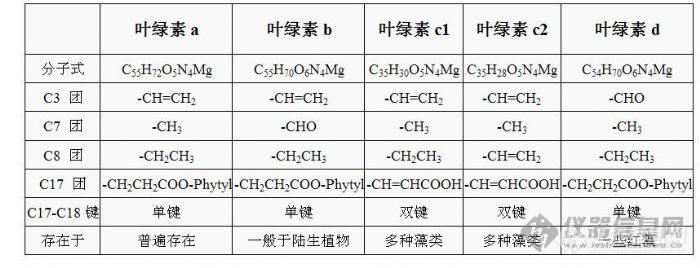
[B]农残分析中净化是最麻烦,但是又是必要的一个环节;特别是在处理植物样品时,植物色素的干扰是一个较为麻烦的问题,常见的净化方法有磺化方法、凝胶色谱(GPC)法或利用吸附剂如活性炭、PSA、石墨化炭黑、氧化铝、弗洛里硅土等进行SPE净化,由于农残目标物的不同及样品的差异,各个净化方法会有不同的适用性。[/B][color=#DC143C]下面就针对不同的样品、分析的目标物等用何种净化方法较为适用,请大家结合自己的实验经验或个人观点发表一下看法、分享一下经验![/color]下面简单的介绍一下色素的相关知识(以下资料均来源于网络)植物色素类(Phytochromes)主要有脂溶往色素与水溶性色素两类。脂溶性色素主要为叶绿素、叶黄素与胡萝卜素,三者常共存。此外尚有藏红花素、辣椒红素等。除叶绿素外,多为四萜衍生物。这类色素不溶于水。难溶于甲醇,易溶于高浓度乙醇、乙醚、氯仿、苯等有机溶剂。胡萝卜素在乙醇中也不溶。叶绿素等在制备中草药制剂或提取其他有效成分时常须作为杂质去除,以使药物纯化,中草药(特别是叶类、全草类)的乙醇提取液中含有多量叶绿素、可在浓缩液中加水使之沉出,也可通过氧化铝、碳酸钙等吸附剂而除去。水溶性色素主要为花色甙类,又称花青素,普遍存在于花中。溶于水及乙醇,不溶于乙醚、氯仿等有机溶剂,遇醋酸铅试剂会沉淀,并能被活性炭吸附,其颜色随pH的不同而会改变。[B]叶绿素[/B]叶绿素是二氢卟酚(chlorin)色素,结构上和卟啉(porphyrin)色素例如血红素类似。在二氢卟酚环的中央有一个镁原子。叶绿素有多个侧链,通常包括一个长的植基(phytyl chain)。以下是自然界中可以找到的几种叶绿素:[img]http://ng1.17img.cn/bbsfiles/images/2008/08/200808022308_101290_1613333_3.jpg[/img]以下是叶绿素的结构:[img]http://ng1.17img.cn/bbsfiles/images/2008/08/200808022310_101291_1613333_3.jpg[/img]叶绿素a、b、d[img]http://ng1.17img.cn/bbsfiles/images/2008/08/200808022312_101294_1613333_3.jpg[/img]叶绿素c1、c2
使用色素以来源的不同,可分为两大类,分别是人工色素和天然色素。食用的人工合成色素通常以煤焦油来制成,各国或地区对对人工色素的使用有严格的限制。天然色素主要来源有三方面是植物,动物,和微生物。天然色素总的来说,安全性高,大部份是源自植物。但是以素食者来说,看见产品注明是天然或是有机,就以为是素食的话,是很不安全的。介定为天然色素的:胭脂虫红色E120, 紫胶红色素(Lac Red)、虾売色素等都是动物性的,素食者忌食。还有等同天然的分类,即是化学合成的色素,其成份和功效与天然提取物完全相同,所以视为等同天然(Nature Identical)看待。就以广受香港人欢迎的斋卤味来说,就分别有人工色素和天然色素。斋卤味可以分为红色的酸斋,黄色的咖喱斋,深色的素蚝油斋。素蚝油斋的色素由蚝油而来,蚝油的色来自焦糖,是深褐色,属于天然色素。咖喱斋的色来自咖喱粉,是香料本身的天然色素。红色的酸斋,可以用茄汁调色,但很多都用人工的红色,因为人工色素,价钱平,颜色靓,不易褪色,这一点后重要,如果容易褪色,食完之后,棚牙都染到红色,就不太好了。不过这些红色不会是花红粉,因为这是工业用的,香港是禁止用在食品上的。人工的煤焦油色素,香港准许用的有十七种左右,英国和欧盟大约二十种,美国约十种,日本十一种,中国有九种。中国准许使用的合成色素有:胭脂红,苋菜红,赤藓红,新红,红色40,柠檬黄,日落黄,靛蓝,亮蓝。不同的国家对食用色素都有自己的名称和编排系统,同一种色素在不同的国家或地区可能用不同的编号。例如,柠檬黄,又叫酒石黄,台湾叫食用黄色4号,美国叫黄色5号,日本又叫黄色4号,英国叫黄色17号,而欧盟叫E102。为咗避免混乱,国际上出咗一套颜色索引编号(Color Index),简称C I ,每一种色素的编号可以对照。所以现在我们在超市,都会发现一些货品有C I 号码。
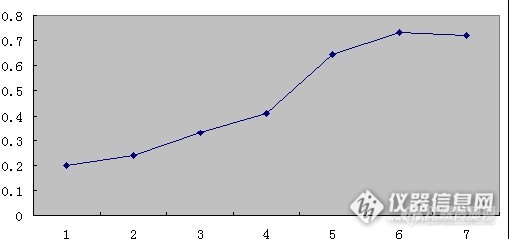
红花苜蓿总黄酮对亚硝酸的清除盐作用研究 亚硝酸盐具有一定的毒性,是食品添加剂中急性毒性最强的物质之一。一方面是大剂量的亚硝酸盐进人人体内会造成中毒,另一方面,部分亚硝酸盐在一定条件下会转化为亚硝胺,而亚硝胺是一种致癌物质。亚硝酸盐进人血液后与人体中的血红蛋白结合,使正常的血红蛋白变形,失去携氧能力,导致人体组织缺氧,还会对血管产生扩张作用。一般地,口服亚硝酸盐10min至3h后,可出现头晕、头痛、乏力、胸闷、气短、心悸、恶心、呕吐、腹痛、腹泻等症状;严重者出现意识丧失、昏迷、呼吸衰竭,甚至死亡。另外亚硝酸盐能够透过胎盘进人胎儿体内,6个月以内的婴儿对亚硝酸盐特别敏感,对胎儿有致畸的作用。 红花苜蓿是一种在在欧洲和亚洲的草地中常见的多年生野生植物,现在已经被移植到北美来种植。在分枝的茎末端生长的红花被认为是其医疗价值的来源,通常会被晒干用作医疗使用。红花苜蓿是很多有价值的营养素的来源,包括钙、铬、镁、烟碱酸、磷、钾、硫胺素和维生素C。红花苜蓿还被认为是异黄酮(一种作用类似雌激素的水溶性化学成分,存在于很多植物中)的最丰富来源之一。 近年来,随着对自由基研究的深入,人体中的活性氧和自由基被认为是引发衰老、癌变和细胞损伤的重要原因。筛选新的能够清除自由基的抗氧化天然药物成为研究热点,因此,对异黄酮抗氧化作用的研究逐渐引起广大学者的重视。 本试验旨在探讨红花苜蓿总黄酮对亚硝酸的清除盐作用,,为防癌抗癌及充分利用这一天然资源提供有益的实验依据。材料与方法主要仪器:电热恒温水浴锅微量紫外分光光度循环水真空泵万分之一分析天平主要试剂: 葡萄糖,对氨基苯磺酸,亚硝酸钠,α-萘胺,pH=3.0的柠檬酸钠-盐酸缓冲液,苯酚,浓硫酸,冰醋酸,以上均为分析纯。红花苜蓿蒸馏水2实验方法主要试剂的配制; 葡萄糖贮备液:精密称取葡萄糖对照品100.0mg,用蒸馏水溶解并定容至100mL。 0.4%对氨基苯磺酸:精密称取对氨基苯磺酸400.0mg溶于100mL 30%醋酸溶液中。 0.1%α-萘胺:精密称取250.1mgα-萘胺溶解于250mL30%醋酸溶液中。100mg/kg亚硝酸钠溶液:精密称取50.2mg亚硝酸钠溶于500mL水中。 pH=3.0的柠檬酸钠-盐酸缓冲液:用适量的柠檬酸钠、盐酸、蒸馏水并用酸度计测pH值配溶液500mL。5%苯酚试剂:精密称取10.0000g,加蒸馏水190g溶解,置棕色瓶中密闭保存。红花苜蓿总黄酮的提取称取干燥的红花苜蓿用石油醚浸泡24h,以除去色素和脂溶性杂质,倾出石油醚,药渣中75%乙醇浸泡30分钟,超声提取30分钟,过滤,收集提取液,浓缩干燥得总黄酮。 2.3[font=
[font=黑体, SimHei][size=16px]点击链接查看更多:[url]https://www.woyaoce.cn/service/info-17824.html[/url]自然界有超过300种不同的花青素。他们来源于不同种水果和蔬菜如紫甘薯、越橘、酸果蔓、黑枸杞、蓝莓、葡萄、接骨木红、黑加仑、紫胡萝卜和红甘蓝、颜色从红到蓝。这些花青素主要包含飞燕草素、矢车菊素、矮牵牛花色素、天竺葵色素、芍药花色素和锦葵色素。[/size][/font][font=黑体, SimHei][size=16px]检测项目[/size][/font][font=黑体, SimHei][size=16px]花青素在植物中的总含量 [/size][/font][font=黑体, SimHei][size=16px]花青素在植物中的分类及百分比 [/size][/font][font=黑体, SimHei][size=16px]花青素糖苷的含量和种类检测。[/size][/font][font=黑体, SimHei][size=16px]检测费用:根据客户检测需求以及实验复杂程度进行报价[/size][/font][font=黑体, SimHei][size=16px]检测流程[/size][/font][font=黑体, SimHei][size=16px]1)电话咨询[/size][/font][font=黑体, SimHei][size=16px]2)工程师报价[/size][/font][font=黑体, SimHei][size=16px]3)邮寄样品或上门取样[/size][/font][font=黑体, SimHei][size=16px]4)支付检测费用,开展实验[/size][/font][font=黑体, SimHei][size=16px]5)完成实验,出具检测报告[/size][/font][font=黑体, SimHei][size=16px]6)邮寄检测报告,售后服务[/size][/font][font=黑体, SimHei][size=16px]菲优特检测服务形式[/size][/font][font=黑体, SimHei][size=16px]委托检测:药品检测、食品/医药/保健品检测、环境检测、化工检测、水产养殖检测、微生物检测、毒理测试等[/size][/font][font=黑体, SimHei][size=16px]科研服务:分子生物学、代谢组学、蛋白质组学、基因组学、细胞服务、细菌服务、新药研发筛选模型构建、疾病动物模型构建及其他开放类服务项目[/size][/font][font=黑体, SimHei][size=16px]方法开发及咨询:实验室检测方法开发和应用、实验室管理咨询和培训、质量控制咨询与培训、实验仪器配置和选型等[/size][/font][font=黑体, SimHei][size=16px]仪器共享[/size][/font][font=黑体, SimHei][size=16px][/size][/font]
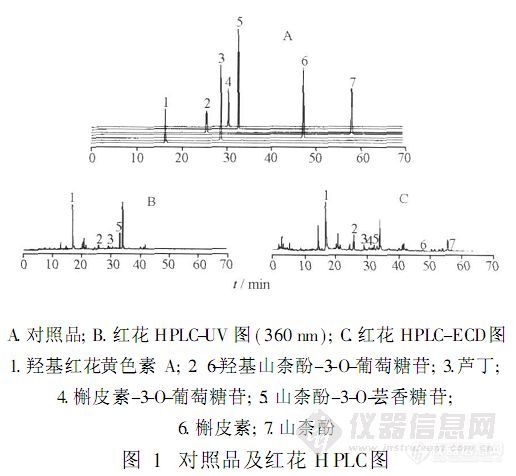
【作者中文名】王若菁; 杨滨; 付梅红;【作者英文名】WANG Ruo-jing; YANG Bin; FU Mei-hong(Institute of Chinese Materia Medica; China Academy of Chinese Medical Sciences; Beijing 100700; China);【作者单位】中国中医科学院中药研究所;【摘要】目的:对红花中色素类成分、腺苷及黄酮类化合物等成分进行分析,建立红花药材质量评价方法。方法:采用高效液相色谱-电化学检测技术,对和指纹图谱红花中羟基红花黄色素A的含量进行研究:Agilent ZORBAXSb C18色谱柱(4.6 mm×250 mm,5μm),以磷酸盐缓冲液-乙腈为流动相进行梯度洗脱,流速1.0 mL.min-1,柱温35℃,参比电极ISAAC(in-situ Ag/AgCl),工作电极为玻碳电极;辅助电极为铂电极;检测电位+800 mV。采用高效液相色谱-紫外检测技术,分析红花中腺苷的含量:Diamonsil C18色谱柱(4.6 mm×250 mm,5μm),流动相水-乙腈(95∶5),流速1.0 mL.min-1,柱温40℃,检测波长260 nm;采用紫外分光光度法,测定红花红色素的吸光度。结果:以21个共有峰为指标,建立了红花高效液相色谱指纹图谱,鉴定出7个色谱峰。32个红花样品中羟基红花黄色素A的质量分数为0.35%~3.58%;腺苷的质量分数为0.03‰~0.49‰。结论:该方法可用于红花质量评价。http://ng1.17img.cn/bbsfiles/images/2012/08/201208131730_383586_2379123_3.jpg
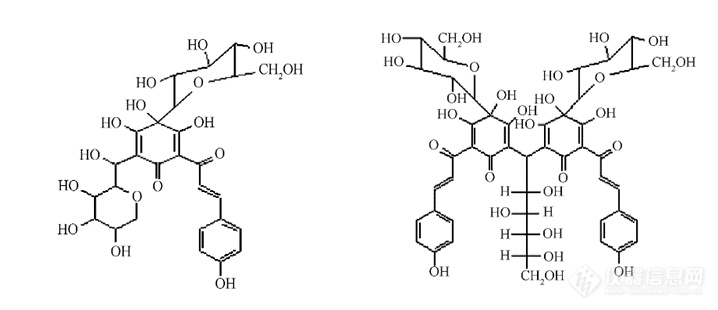
[font='黑体'][size=48px]食品添加剂——红花黄[/size][/font][font='times new roman'][size=24px]肖淑玲[/size][/font][font='times new roman'][size=24px]2021.7[/size][/font][align=center][/align][font='calibri']摘要:[/font][font='calibri']红花是[/font][font='times new roman']菊科植物的干燥花[/font][font='times new roman'],[/font][font='calibri']是具有多种疗效的名贵中草药。从红花中提取的红花黄色素不仅是重要的天然食用色素,也具有保护心脑血管、免疫抑制等多种药理功能,一直以来都是色素界的研究热点。本文从理化性质、稳定性、制备方法、应用研究及检测方法等多方面综述了红花黄色素,帮助读者全面了解红花黄色素,尤其是了解如何运用国标检测方法测定红花黄食品添加剂含量。[/font][font='宋体']关键词:[/font][font='宋体'][size=16px]食品添加剂[/size][/font][font='宋体'][size=16px],[/size][/font][font='宋体'][size=16px]红花黄[/size][/font][font='宋体'][size=16px],[/size][/font][font='宋体'][size=16px]色素[/size][/font]1、 [font='calibri'][size=18px]引言[/size][/font][font='times new roman']红花是中国重要的中草药,为菊科植物的干燥花,内含红花红色素和红花黄色素两种色素,其性温、味辛,具有活血通经、祛瘀止痛、降低胆固醇、降血压等功效,主要用于月经不调、痛经、经闭、跌打损伤,对冠心病、传染性肝炎等疾病亦有一定的疗效。红花黄色素是从红花的花瓣中提取出的天然黄色素,为查耳酮类化合物。[/font][font='times new roman']红花黄色素是[/font][font='times new roman']我国[/font][font='times new roman']食用天然色素[/font][font='times new roman']的一种[/font][font='times new roman'],主要[/font][font='times new roman']成分[/font][font='times new roman']为红花黄色素[/font][font='times new roman']A[/font][font='times new roman']。研究发现红花黄色素[/font][font='times new roman']不仅[/font][font='times new roman']具有色泽艳丽[/font][font='times new roman']、[/font][font='times new roman']耐高压、耐低温、耐光、耐酸、耐还原和抗微生物等优点,而且还有扩张冠状动脉、抗氧化、保护心肌、降血压、免疫抑制和脑保护等多种药理功能[/font][font='times new roman'],已经被归为国家级新药[/font][font='times new roman']。[/font][font='times new roman']红花黄色素因其优良的着色性能和独特的药理功能,一直在我国色素界大放异彩,饱受关注。[/font]2、 [font='宋体'][size=18px]理化性质[/size][/font][font='times new roman'][color=#333333][back=#ffffff]红花黄色素为黄色或棕黄色粉末,熔点[/back][/color][/font][font='times new roman'][color=#333333][back=#ffffff]230℃[/back][/color][/font][font='times new roman'][color=#333333][back=#ffffff]。它具有亲水性,[/back][/color][/font][font='times new roman'][color=#333333][back=#ffffff]易溶于水、稀乙醇、稀丙二醇,[/back][/color][/font][font='times new roman'][color=#333333][back=#ffffff]其水溶液呈鲜艳黄色,不产生沉淀,[/back][/color][/font][font='times new roman'][color=#333333][back=#ffffff]几乎不溶于无水乙醇,不溶于乙醚、石油醚、油脂、氯仿等有机溶剂[/back][/color][/font][font='times new roman'][color=#333333][back=#ffffff]。[/back][/color][/font][font='times new roman'][color=#333333][back=#ffffff]红花黄色素的[/back][/color][/font][font='times new roman'][color=#333333][back=#ffffff]颜色随[/back][/color][/font][font='times new roman'][color=#333333][back=#ffffff]pH [/back][/color][/font][font='times new roman'][color=#333333][back=#ffffff]的不同而改变。在[/back][/color][/font][font='times new roman'][color=#333333][back=#ffffff]pH [/back][/color][/font][font='times new roman'][color=#333333][back=#ffffff]值[/back][/color][/font][font='times new roman'][color=#333333][back=#ffffff]2[/back][/color][/font][font='times new roman'][color=#333333][back=#ffffff]-[/back][/color][/font][font='times new roman'][color=#333333][back=#ffffff]7[/back][/color][/font][font='times new roman'][color=#333333][back=#ffffff]范围的酸性溶液中[/back][/color][/font][font='times new roman'][color=#333333][back=#ffffff]颜色稳定性强[/back][/color][/font][font='times new roman'][color=#333333][back=#ffffff],呈黄色[/back][/color][/font][font='times new roman'][color=#333333][back=#ffffff];[/back][/color][/font][font='times new roman'][color=#333333][back=#ffffff]在[/back][/color][/font][font='times new roman'][color=#333333][back=#ffffff]碱性溶液中呈黄橙色,耐光性好,耐热性稍差。[/back][/color][/font][font='times new roman'][color=#333333][back=#ffffff]红花黄色素[/back][/color][/font][font='times new roman'][color=#333333][back=#ffffff]毒性极低、着色力强、色调稳定[/back][/color][/font][font='times new roman'][color=#333333][back=#ffffff];[/back][/color][/font][font='times new roman'][color=#333333][back=#ffffff]在红花中含量为[/back][/color][/font][font='times new roman'][color=#333333][back=#ffffff]20% ~ 30%[/back][/color][/font][font='times new roman'][size=13px][1][/size][/font][font='times new roman'][color=#333333][back=#ffffff]。[/back][/color][/font][font='宋体']红花黄色素结构如下图[/font][font='宋体']一[/font][font='宋体'],为[/font][font='times new roman']查耳酮类化合物。[/font][font='times new roman']红花黄色素[/font][font='times new roman']A[/font][font='times new roman']分子式为[/font][font='times new roman']C[/font][font='times new roman'][size=13px]27[/size][/font][font='times new roman']H[/font][font='times new roman'][size=13px]32[/size][/font][font='times new roman']O[/font][font='times new roman'][size=13px]16[/size][/font][font='times new roman'],相对分子质量为[/font][font='times new roman']612.5[/font][font='times new roman']。红花黄色素[/font][font='times new roman']B[/font][font='times new roman']分子式为[/font][font='times new roman']C[/font][font='times new roman'][size=13px]48[/size][/font][font='times new roman']H[/font][font='times new roman'][size=13px]54[/size][/font][font='times new roman']O[/font][font='times new roman'][size=13px]27[/size][/font][font='times new roman'],相对分子质量为[/font][font='times new roman']1062[/font][font='times new roman'][size=13px][[/size][/font][font='times new roman'][size=13px]2][/size][/font][font='times new roman']。[/font][font='times new roman']商品化的红花黄产品应以符合国家标准的红花黄为原料,可添加食用糊精等食品辅料而制成。[/font][img]https://ng1.17img.cn/bbsfiles/images/2021/08/202108042202375558_3661_1608728_3.png[/img][align=center][font='宋体']图[/font][font='宋体']1[/font][font='宋体'].[/font]红花黄色素结构式:图左为红花黄色素A,图右为红花黄色素B[font='times new roman'][size=16px][[/size][/font][font='times new roman'][size=16px]2][/size][/font][/align]3、 [font='宋体'][size=18px]稳定性[/size][/font][font='times new roman']红花黄色素的稳定性,主要表现在其水溶性好、热稳定性好、金属离子对其影响小等[/font][font='times new roman']多个[/font][font='times new roman']方面。[/font][font='times new roman']研究表明,红花黄色素易溶于水、稀乙醇等强极性溶剂,难溶于无水乙醇、丙酮等弱极性有机溶剂。[/font][font='times new roman']光照或日晒对红花黄色素有一定的影响,[/font][font='times new roman']应该避光保存。[/font][font='times new roman']但[/font][font='times new roman']它[/font][font='times new roman']不受紫外光的影响,其耐光性较好。[/font][font='times new roman']p[/font][font='times new roman']H[/font][font='times new roman']3. 4[/font][font='times new roman']时,[/font][font='times new roman']10[/font][font='times new roman']0°C[/font][font='times new roman']加热[/font][font='times new roman']1 h[/font][font='times new roman']保存率在[/font][font='times new roman']80%[/font][font='times new roman']以上,说明其耐热性好[/font][font='times new roman'][size=13px][[/size][/font][font='times new roman'][size=13px]1][/size][/font][font='times new roman']。[/font][font='times new roman']但[/font][font='times new roman']红花黄色素[/font][font='times new roman']热稳定性不好[/font][font='times new roman'],当温度高于[/font][font='times new roman']60[/font][font='times new roman'] °C[/font][font='times new roman'], [/font][font='times new roman']加热一定时间后[/font][font='times new roman'], [/font][font='times new roman']羟基红花黄色素[/font][font='times new roman']A[/font][font='times new roman']就会发生水解[/font][font='times new roman'][size=13px][[/size][/font][font='times new roman'][size=13px]3[/size][/font][font='times new roman'][size=13px]][/size][/font][font='times new roman']。[/font][font='times new roman']经[/font][font='times new roman']Ca[/font][font='times new roman']、[/font][font='times new roman']Mg[/font][font='times new roman']等金属离子对其影响[/font][font='times new roman']的实验[/font][font='times new roman']结果表明,[/font][font='times new roman']Na[/font][font='times new roman'][size=13px]+[/size][/font][font='times new roman']、[/font][font='times new roman']Zn[/font][font='times new roman'][size=13px]2+[/size][/font][font='times new roman']、[/font][font='times new roman']Ca[/font][font='times new roman'][size=13px]2+[/size][/font][font='times new roman']、[/font][font='times new roman']Sn[/font][font='times new roman'][size=13px]2+[/size][/font][font='times new roman']对色素有增色作用,色素对[/font][font='times new roman']Fe[/font][font='times new roman'][size=13px]3+[/size][/font][font='times new roman']、[/font][font='times new roman']Cu[/font][font='times new roman'][size=13px]2+[/size][/font][font='times new roman']、[/font][font='times new roman']Vc[/font][font='times new roman']较敏感。[/font][font='times new roman']F[/font][font='times new roman']e[/font][font='times new roman'][size=13px]2+[/size][/font][font='times new roman']对色素影响较大[/font][font='times new roman'], [/font][font='times new roman']使其颜色变暗[/font][font='times new roman'], [/font][font='times new roman']且吸光度峰值随[/font][font='times new roman']F[/font][font='times new roman']e[/font][font='times new roman'][size=13px]2[/size][/font][font='times new roman'][size=13px]+[/size][/font][font='times new roman']浓度增高而向紫外光移动[/font][font='times new roman'], [/font][font='times new roman']还会产生乳浊液。蔗糖、淀粉、柠檬酸在短时间内能与色素共存,食盐、蔗糖、[/font][font='times new roman']H[/font][font='times new roman'][size=13px]2[/size][/font][font='times new roman']O[/font][font='times new roman'][size=13px]2[/size][/font][font='times new roman']、抗坏血酸、亚硫酸钠等一定浓度的溶液除亚硫酸钠有轻微的减色作用,糖、盐等均有不同的增色作用。色素对氧化剂较稳定[/font][font='times new roman'],[/font][font='times new roman']但还原剂对色素影响较大[/font][font='times new roman']。[/font][font='times new roman']因此[/font][font='times new roman'],[/font][font='times new roman']建议在使用色素时应避免与还原剂一起使用[/font][font='times new roman']。[/font][font='times new roman'][size=13px][[/size][/font][font='times new roman'][size=13px]1][/size][/font][font='times new roman'][size=13px][[/size][/font][font='times new roman'][size=13px]4][/size][/font][font='times new roman']提取方法对红花黄色素稳定性也有很大影响,红花黄色素不易在高温下提取或保存。黄宇玫等[/font][font='times new roman']人[/font][font='times new roman'][size=13px][[/size][/font][font='times new roman'][size=13px]5][/size][/font][font='times new roman']通过单因素和正交实验方法,对提取温度、浸取时间、溶剂用量进行考察,得出实验条件为:分别加[/font][font='times new roman']20[/font][font='times new roman']倍量的水提取[/font][font='times new roman']2[/font][font='times new roman']次[/font][font='times new roman'], [/font][font='times new roman']在[/font][font='times new roman']40[/font][font='times new roman'] °C[/font][font='times new roman']下[/font][font='times new roman'], 2[/font][font='times new roman']次浸取时间分别为[/font][font='times new roman']12 h[/font][font='times new roman']和[/font][font='times new roman']4 h[/font][font='times new roman'],[/font][font='times new roman']过滤[/font][font='times new roman'],[/font][font='times new roman']合并滤液。在此实验条件下,红花黄色素具有较好的稳定性。文章也指出,目前除了采用上述的提取方法对色素进行提取以提高色素稳定性外[/font][font='times new roman'], [/font][font='times new roman']主要的措施还有:加入稳定剂、抗氧化剂、金属离子封锁剂或天然色素的改性。[/font][font='times new roman']开发新的提取方法对提高所得色素的稳定性也具有重要意义,[/font][font='times new roman']如酶工程法得到的有效成分较其他方法就会更加稳定。[/font]4、 [font='宋体'][size=18px]制备方法[/size][/font]1. [font='宋体'][size=16px]传统方法[/size][/font][font='times new roman']传统的提取方法为[/font][font='times new roman']:[/font][font='times new roman']水提取法、有机溶剂沉淀精制法。主要操作方法就是把红花弄碎后用蒸馏水将其浸泡[/font][font='times new roman'], [/font][font='times new roman']然后经过过滤[/font][font='times new roman'], [/font][font='times new roman']得到浓缩液[/font][font='times new roman'],[/font][font='times new roman']将浓缩液中的沉淀与纯液体进行离心分离、干燥、粉碎。但是过去的实验[/font][font='times new roman']已经[/font][font='times new roman']发现应用传统的方式提取得到的成品的浓度不是很高[/font][font='times new roman'], [/font][font='times new roman']含有很多的杂质[/font][font='times new roman'], [/font][font='times new roman']不利于保存。[/font][font='times new roman']经过不断的改进[/font][font='times new roman'], [/font][font='times new roman']研究人员[/font][font='times new roman']不断完善了传统的溶剂提取方法[/font][font='times new roman'], [/font][font='times new roman']目前最理想的提取方法为[/font][font='times new roman']:[/font][font='times new roman']选择溶剂为[/font][font='times new roman']pH 8.9[/font][font='times new roman']的水溶液[/font][font='times new roman'], [/font][font='times new roman']液料比[/font][font='times new roman']25 mL/g[/font][font='times new roman'],[/font][font='times new roman']将红花放于[/font][font='times new roman']73 °C[/font][font='times new roman']下进行提取,一共要提取[/font][font='times new roman']3[/font][font='times new roman']次[/font][font='times new roman'], [/font][font='times new roman']每次浸泡的时间一定要充足[/font][font='times new roman'], [/font][font='times new roman']掌握在[/font][font='times new roman']98min[/font][font='times new roman']左右[/font][font='times new roman'], [/font][font='times new roman']满足了这些提取条件[/font][font='times new roman'], [/font][font='times new roman']得到的黄色素的成品质量很好[/font][font='times new roman'][size=13px][6][/size][/font][font='times new roman']。[/font]2. [font='宋体'][size=16px]大孔吸附树脂法[/size][/font][font='calibri']大[/font][font='times new roman']孔吸附树脂是[/font][font='times new roman']一类新型的非离子型有机高聚物吸附剂[/font][font='times new roman'],它[/font][font='times new roman']具有吸附容量大、选择性好、吸附速度快、解析容易、可反复使用等优点,[/font][font='times new roman']目前作为理想的黄色素提取法在广泛应用中。[/font][font='times new roman']彭永芳等人[/font][font='times new roman'][size=13px][[/size][/font][font='times new roman'][size=13px]7][/size][/font][font='times new roman']研究发现[/font][font='times new roman']将[/font][font='times new roman']AB-8[/font][font='times new roman']树脂作吸附剂[/font][font='times new roman'], [/font][font='times new roman']洗脱剂用[/font][font='times new roman']80 %[/font][font='times new roman']的乙醇[/font][font='times new roman'], [/font][font='times new roman']这样提取的成品质量较传统法好,产品杂质少,色价高,成本较低,工艺简单,收率高达干花重的[/font][font='times new roman']23. 3 %[/font][font='times new roman']。同时表明,[/font][font='times new roman']AB-8[/font][font='times new roman']树脂稳定性好,使用[/font][font='times new roman']17[/font][font='times new roman']次后其吸附率仅降低[/font][font='times new roman']2. 32 % [/font][font='times new roman']。因此,该方法适合红花黄色素的分离纯化。[/font]3. [font='宋体'][size=16px]超声波辅助提取[/size][/font][font='宋体'][size=16px][[/size][/font][font='宋体'][size=16px]8[/size][/font][font='宋体'][size=16px]][/size][/font][font='times new roman']红花黄色素[/font][font='times new roman']在高温下不够稳定,[/font][font='times new roman']超声辅助提取可以避免常规溶剂提取由于提取温度高对[/font][font='times new roman']热不稳定性[/font][font='times new roman']物质的破坏[/font][font='times new roman'],[/font][font='times new roman']且具有节能、省时、溶剂用量少、提取效率高等优点[/font][font='times new roman'], [/font][font='times new roman']目前已[/font][font='times new roman']被较多的应用于红花中黄色素的提取。[/font][font='times new roman']肖艳华[/font][font='times new roman']等人[/font][font='times new roman']研究了红花中黄色素[/font][font='times new roman']A[/font][font='times new roman']的超声提取工艺[/font][font='times new roman'],[/font][font='times new roman']结果表明[/font][font='times new roman'],[/font][font='times new roman']影响红花黄色素[/font][font='times new roman']A[/font][font='times new roman']超声辅助提取[/font][font='times new roman']因素[/font][font='times new roman']的主次顺序为[/font][font='times new roman']:[/font][font='times new roman']超声时间[/font][font='times new roman'][/font][font='times new roman']乙醇浓度[/font][font='times new roman'][/font][font='times new roman']提取温度[/font][font='times new roman'][/font][font='times new roman']溶剂用[/font][font='times new roman']量,[/font][font='times new roman']最佳提取工艺条件为[/font][font='times new roman']:[/font][font='times new roman']质量分数[/font][font='times new roman']70 %[/font][font='times new roman']乙醇为溶剂[/font][font='times new roman'],[/font][font='times new roman']提取温度[/font][font='times new roman']50 [/font][font='times new roman']°C[/font][font='times new roman'],[/font][font='times new roman']料液比[/font][font='times new roman']1[/font][font='times new roman']:[/font][font='times new roman']10[/font][font='times new roman'],[/font][font='times new roman']超声时间[/font][font='times new roman']20 min[/font][font='times new roman']。[/font][font='times new roman']此工艺条件下[/font][font='times new roman'], [/font][font='times new roman']红花黄色素[/font][font='times new roman']A[/font][font='times new roman']的提取率为[/font][font='times new roman']11.23 %[/font][font='times new roman']。[/font][font='times new roman']虽然超声辅助提取采用全物理过程[/font][font='times new roman'], [/font][font='times new roman']无任何污染[/font][font='times new roman'], [/font][font='times new roman']是一条理想的提取红花黄色素的途径[/font][font='times new roman'], [/font][font='times new roman']但由于超声提取设备的研发相对滞后[/font][font='times new roman'], [/font][font='times new roman']离实现[/font][font='times new roman']大规模[/font][font='times new roman']工业化生产还有较大距离。[/font]4. [font='宋体'][size=16px]微波辅助提取[/size][/font][font='宋体'][size=16px][[/size][/font][font='宋体'][size=16px]8[/size][/font][font='宋体'][size=16px]][/size][/font][font='times new roman']微波辅助提取是基于微波具有[/font][font='times new roman']良好的[/font][font='times new roman']吸收性、穿透性[/font][font='times new roman'],[/font][font='times new roman']可对原料和提取溶剂均匀加热[/font][font='times new roman'],[/font][font='times new roman']从而加速活性成分的溶出。微波辅助提取红花黄色素不仅无污染、成本低、且提取率高、提取时间短、节约能源[/font][font='times new roman'], [/font][font='times new roman']值得深入研究。[/font][font='times new roman']但是加热时温度对活性成分或许有影响,仍需探索。[/font]5. [font='宋体'][size=16px]酶辅助提取[/size][/font][font='宋体'][size=16px][[/size][/font][font='宋体'][size=16px]8][/size][/font][font='times new roman']酶辅助提取利用各种酶[/font][font='times new roman']有效[/font][font='times new roman']分解原料的细胞壁及细胞间质中的纤维素、半纤维素和果胶等物质[/font][font='times new roman'], [/font][font='times new roman']减少传质阻力[/font][font='times new roman'], [/font][font='times new roman']促进活性成分的溶出。[/font][font='times new roman']杜辉等采用[/font][font='times new roman']1[/font][font='times new roman']:[/font][font='times new roman']1[/font][font='times new roman']纤维素酶与果胶酶复合酶辅助提取红花中黄色素[/font][font='times new roman'],[/font][font='times new roman']通过响应面法分析得到[/font][font='times new roman']:[/font][font='times new roman']酶用量对红花黄色素提取率有极显著影响[/font][font='times new roman'],[/font][font='times new roman']pH[/font][font='times new roman']、酶用量与酶解温度交互作用、[/font][font='times new roman']p[/font][font='times new roman']H[/font][font='times new roman']与酶解温度交互作用对提取率有显著影响。其研究得出的优化提取工艺为:酶解温度[/font][font='times new roman']47[/font][font='times new roman'] °[/font][font='times new roman']C, pH[/font][font='times new roman']值[/font][font='times new roman']4.7[/font][font='times new roman'],[/font][font='times new roman']酶解时间[/font][font='times new roman']2.0 h[/font][font='times new roman'],[/font][font='times new roman']酶用量[/font][font='times new roman']0.64%[/font][font='times new roman'][size=13px][[/size][/font][font='times new roman'][size=13px]9[/size][/font][font='times new roman'][size=13px]][/size][/font][font='times new roman']。[/font][font='times new roman']酶辅助提取方法具有提取率高、提取条件温和及有效成分理化性质稳定的特点。但是该方法相对成本较高,应用规模尚小。[/font]6. [font='calibri'][size=16px]闪式提取[/size][/font][font='calibri'][size=16px][[/size][/font][font='calibri'][size=16px]8[/size][/font][font='calibri'][size=16px]][/size][/font][font='times new roman']闪式提取[/font][font='times new roman']可[/font][font='times new roman']在室温下[/font][font='times new roman'], [/font][font='times new roman']依靠闪式提取器的高速机械剪切力和超动分子渗透技术[/font][font='times new roman'],[/font][font='times new roman']使活性成分快速达到在提取剂与原料组织中平衡[/font][font='times new roman'],[/font][font='times new roman']再通过过滤达到提取分离[/font][font='times new roman']。[/font][font='times new roman']具有溶剂用量少[/font][font='times new roman'],[/font][font='times new roman']快速、安全、节能、高效等优点[/font][font='times new roman'], [/font][font='times new roman']极具开发应用前景。[/font]7. [font='宋体'][size=16px]减压提取[/size][/font][font='宋体'][size=16px][[/size][/font][font='宋体'][size=16px]8[/size][/font][font='宋体'][size=16px]][/size][/font][font='times new roman']减压提取是[/font][font='times new roman']一种新型提取方法,[/font][font='times new roman']采用在常规提取器上加装真空系统[/font][font='times new roman']的方法[/font][font='times new roman'], [/font][font='times new roman']使提取操作[/font][font='times new roman']在[/font][font='times new roman']负压状态下进行[/font][font='times new roman'],从而[/font][font='times new roman']降低提取剂沸点[/font][font='times new roman'],[/font][font='times new roman']使提取剂在低温下沸腾[/font][font='times new roman'],[/font][font='times new roman']实现活性成分有效提取[/font][font='times new roman'],并[/font][font='times new roman']避免活性成分被破坏。减压提取可有效降低提取温度[/font][font='times new roman'],[/font][font='times new roman']缩短提取时间[/font][font='times new roman'],[/font][font='times new roman']成本低廉[/font][font='times new roman'],[/font][font='times new roman']有[/font][font='times new roman']广阔的前景,有[/font][font='times new roman']必要深入研究。[/font]5、 [font='宋体'][size=18px]应用研究[/size][/font]1. [font='宋体'][size=16px]食品着色[/size][/font][font='宋体']红花黄色素作为一种天然、安全的食用色素[/font][font='宋体'],[/font][font='宋体']已成功应用于各种饮料、酒类及保健食品的着色。由于人工合成的柠檬黄为有毒色素,现已被许多国家禁止使用,红花黄色素可作为其首选色素[/font][font='宋体'],尤其是用于婴幼儿和老年保健食品。[/font]2. [font='宋体'][size=16px]纺织染色[/size][/font][font='宋体']红花黄色素具有[/font][font='宋体']色泽[/font][font='宋体']艳丽[/font][font='宋体']和低毒等优点,在纺织业的染色中亦有出色应用。但红花黄色素提取、精制方法繁琐,生理功能机理研究不完善,因此离推广应用仍有很大距离。[/font][font='宋体']要想大规模应用,[/font][font='宋体']未来的研究重点应是简化工艺,提高产量,深入其功能机理研究。[/font]3. [font='宋体'][size=16px]医[/size][/font][font='宋体'][size=16px]药疗效[/size][/font][font='宋体']研究表明,红花黄色素具有抗炎、镇痛、抗氧化等多种疗效,在治疗心脑血管疾病、糖尿病、肿瘤等疾病方面也展现出了令人惊喜的药理潜力。红花黄色素目前已被归类为国家级新药,相信在未来会有更多与红花黄有关的药物面世。[/font]6、 [font='calibri'][size=18px]用量要求[/size][/font][font='times new roman']《食品添加剂使用卫生标准》[/font][font='times new roman'](GB2760-2011)[/font][font='times new roman']规定[/font][font='times new roman']:[/font][font='times new roman']红花黄[/font][font='times new roman']色素[/font][font='times new roman']主要用于果味型饮料[/font][font='times new roman'] ([/font][font='times new roman']固体、液体[/font][font='times new roman'])[/font][font='times new roman']、果汁型饮料、汽水、各类果酒、配制酒、糖果、糕点上彩妆、红绿丝、果酱、水果罐头、冰制品、浓缩果汁、青梅、冰淇淋、冰棍、蜜饯和果冻,最大使用量为[/font][font='times new roman']0.2 g/kg[/font][font='times new roman']。[/font]7、 [font='宋体'][size=18px]检测方法[/size][/font]1. [font='times new roman'][size=16px]高效液相色谱法([/size][/font][font='times new roman'][size=16px]HPLC[/size][/font][font='times new roman'][size=16px])[/size][/font][font='times new roman']已报道的红花黄色素含量测定方法主要为光度法、毛细管电泳法和[/font][font='times new roman']HPLC[/font][font='times new roman']法。[/font][font='times new roman']光度法仅能测定黄色素总量,[/font][font='times new roman']已报道的[/font][font='times new roman']毛细管电泳法可测定[/font][font='times new roman']Safflomin A[/font][font='times new roman'],[/font][font='times new roman']Safflomin C[/font][font='times new roman'],[/font][font='times new roman']Safflower yellow B[/font][font='times new roman']三种黄色素。而[/font][font='times new roman']王慧琴、谢明勇等人[/font][font='times new roman'][size=13px][[/size][/font][font='times new roman'][size=13px]10][/size][/font][font='times new roman']用反相高效液相色谱法,梯度洗脱,同时测定了不同产地红花中[/font][font='times new roman']Safflomin A[/font][font='times new roman']、[/font][font='times new roman']Safflower yellow A[/font][font='times new roman']、[/font][font='times new roman']Safflower yellow B[/font][font='times new roman']和[/font][font='times new roman']Safflomin C[/font][font='times new roman']四种红花黄色素的含量。该方法准确度高[/font][font='times new roman'], [/font][font='times new roman']重现性好。四种红花黄色素检出限分别[/font][font='times new roman']4.0[/font][font='times new roman']、[/font][font='times new roman']8.1[/font][font='times new roman']、[/font][font='times new roman']2.8[/font][font='times new roman']和[/font][font='times new roman']5.0 mg/L[/font][font='times new roman']。[/font][font='times new roman']唐刚等人[/font][font='times new roman'][size=13px][[/size][/font][font='times new roman'][size=13px]11][/size][/font][font='times new roman']用反相高效液相色谱法测定了红花[/font][font='times new roman']W/O[/font][font='times new roman']型乳膏剂中羟基红花黄色素[/font][font='times new roman']A[/font][font='times new roman']含量。检测结果显示,乳膏剂中辅料不影响有效成分羟基红花黄色素[/font][font='times new roman']A[/font][font='times new roman']的含量测定[/font][font='times new roman'],该方法检测限为[/font][font='times new roman']23.6 ng/mL,[/font][font='times new roman']定量限为[/font][font='times new roman']118 ng/mL[/font][font='times new roman']。较之王慧琴等人的研究,其对于羟基红花黄素的测定更加精密准确。[/font][font='times new roman']H[/font][font='times new roman']PLC[/font][font='times new roman']方法主要用于各品种红花[/font][font='times new roman']、[/font][font='times new roman']以红花[/font][font='times new roman']黄[/font][font='times new roman']为主要成分的乳膏、药丸、针剂等产品中红花黄色素含量的测定,[/font][font='times new roman']食品中红花黄含量测定也[/font][font='times new roman']可[/font][font='times new roman']运用[/font][font='times new roman']H[/font][font='times new roman']PLC[/font][font='times new roman']方法。此法[/font][font='times new roman']具有高效、准确、重现性好等优点。但是[/font][font='times new roman']H[/font][font='times new roman']PLC[/font][font='times new roman']方法也存在仪器贵重、操作复杂等局限。[/font]2. [font='times new roman'][size=16px]国家标准[/size][/font][font='times new roman'][size=16px]GB 1886.61-2015[/size][/font][font='times new roman'][size=16px][2][/size][/font][font='times new roman']食品中[/font][font='times new roman']所用[/font][font='times new roman']红花黄色素添加剂主要采用国家标准[/font][font='times new roman']GB 1886.61[/font][font='times new roman']-[/font][font='times new roman']2015[/font][font='times new roman']中规定的方法进行鉴别和测定,测定对象为[/font][font='times new roman']从红花中提取的[/font][font='times new roman']红花黄色素[/font][font='times new roman']A[/font][font='times new roman']和红花黄色素[/font][font='times new roman']B[/font][font='times new roman']样品[/font][font='times new roman']。[/font][font='times new roman']检测鉴定[/font][font='times new roman']时应先测定并计算色价,计算方法见下文[/font][font='times new roman']2[/font][font='times new roman'].3[/font][font='times new roman']。[/font][font='times new roman'][size=16px]2.1[/size][/font][font='times new roman'][size=16px]技术要求[/size][/font][font='宋体']红花黄色素感官要求应符合下表1:[/font][img]https://ng1.17img.cn/bbsfiles/images/2021/08/202108042202377271_2806_1608728_3.png[/img][align=center][font='times new roman']表[/font][font='times new roman']1.[/font][font='times new roman']红花黄感官要求[/font][font='times new roman'][size=13px][[/size][/font][font='times new roman'][size=13px]2][/size][/font][/align][font='times new roman']红花黄理化指标应符合下表[/font][font='times new roman']2[/font][font='times new roman']:[/font][img]https://ng1.17img.cn/bbsfiles/images/2021/08/202108042202378882_9077_1608728_3.png[/img][align=center][font='times new roman']表[/font][font='times new roman']2.[/font][font='times new roman']红花黄理化指标[/font][font='times new roman'][size=13px][[/size][/font][font='times new roman'][size=13px]2][/size][/font][/align]2.2 [font='times new roman'][size=16px]鉴别试验[/size][/font][font='times new roman']2.2.1[/font][font='times new roman']溶解性试验[/font][font='times new roman']红花黄[/font][font='times new roman']易溶于水,微溶于[/font][font='times new roman']乙醇,几乎不溶于乙醚,可通过溶解性试验鉴别。[/font][font='times new roman']2.2.2[/font][font='times new roman']吸光度[/font][font='times new roman']([/font][font='times new roman']1[/font][font='times new roman'])[/font][font='times new roman']试剂与材料:柠檬酸[/font][font='times new roman']-[/font][font='times new roman']磷酸氢二钠缓冲溶液[/font][font='times new roman']([/font][font='times new roman']pH 5.0[/font][font='times new roman']):称取[/font][font='times new roman']21 g[/font][font='times new roman']一水合柠檬酸,溶于[/font][font='times new roman']1000 mL[/font][font='times new roman']水中,此为溶液[/font][font='times new roman']A[/font][font='times new roman'];称取[/font][font='times new roman']71.6 g[/font][font='times new roman']十二水合磷酸氢二钠,溶于[/font][font='times new roman']1000 mL[/font][font='times new roman']水中,此为溶液[/font][font='times new roman']B[/font][font='times new roman'];将溶液[/font][font='times new roman']A[/font][font='times new roman']与溶液[/font][font='times new roman']B[/font][font='times new roman']混合([/font][font='times new roman']97+103[/font][font='times new roman'])。若混合液[/font][font='times new roman']pH[/font][font='times new roman']不为[/font][font='times new roman']5.0[/font][font='times new roman'],则用溶液[/font][font='times new roman']A[/font][font='times new roman']或溶液[/font][font='times new roman']B[/font][font='times new roman']调整至[/font][font='times new roman']pH 5.0[/font][font='times new roman']。[/font][font='times new roman']([/font][font='times new roman']2[/font][font='times new roman'])测定:称取质量相当于[/font][font='times new roman']0.1 g[/font][font='times new roman']、色价为[/font][font='times new roman']10[/font][font='times new roman']的试样,用柠檬酸[/font][font='times new roman']-[/font][font='times new roman']磷酸氢二钠缓冲溶液([/font][font='times new roman']pH 5.0[/font][font='times new roman'])溶解并稀释至[/font][font='times new roman']100 mL[/font][font='times new roman'],此试样液在[/font][font='times new roman']400-408 nm[/font][font='times new roman']有最大吸收峰。[/font][font='times new roman']2.2.3[/font][font='times new roman']颜色反应[/font][font='times new roman']在[/font][font='times new roman']2.2.2[/font][font='times new roman']的测定试样液中加入[/font][font='times new roman']NaOH[/font][font='times new roman']溶液([/font][font='times new roman']40 g/L[/font][font='times new roman']),使溶液变为碱性,试样液色泽变为橙色。[/font][font='times new roman']2.2.4[/font][font='times new roman']薄层色谱[/font][font='times new roman']称取质量相当于[/font][font='times new roman']0.1 g[/font][font='times new roman']、色价为[/font][font='times new roman']10 [/font][font='times new roman']的试样,用[/font][font='times new roman']1 mL[/font][font='times new roman']水溶解,加入[/font][font='times new roman']10 mL[/font][font='times new roman']甲醇混匀,[/font][font='times new roman']3000 r/min[/font][font='times new roman']离心[/font][font='times new roman']10 min[/font][font='times new roman'],取上清液[/font][font='times new roman']20 μL[/font][font='times new roman'],点样于微晶纤维素薄层色谱板(预先在[/font][font='times new roman']60-80°C[/font][font='times new roman']下活化[/font][font='times new roman']20 min[/font][font='times new roman'])上[/font][font='times new roman'],干燥,置于展开剂(正丁醇:乙酸:水[/font][font='times new roman']=4:1:2[/font][font='times new roman'])中展开。当溶剂前沿上升至距原点约[/font][font='times new roman']10 cm[/font][font='times new roman']时,取出薄板,在空气中干燥。薄板上至少有两个黄色斑点,[/font][font='times new roman']R[/font][font='times new roman'][size=13px]f[/size][/font][font='times new roman']值应在[/font][font='times new roman']0.2-0.5[/font][font='times new roman']之间。[/font][font='times new roman'][size=16px]2.3[/size][/font][font='times new roman'][size=16px]色价[/size][/font][font='times new roman'][size=16px]([/size][/font][font='times new roman'][size=16px]400-408 nm[/size][/font][font='times new roman'][size=16px])的测定[/size][/font][font='times new roman']2.3.1[/font][font='times new roman']仪器与材料[/font][font='times new roman'][size=16px]([/size][/font][font='times new roman']1[/font][font='times new roman'])仪器与设备:分光光度计[/font][font='times new roman']([/font][font='times new roman']2[/font][font='times new roman'])试剂与材料:柠檬酸[/font][font='times new roman']-[/font][font='times new roman']磷酸氢二钠缓冲溶液([/font][font='times new roman']pH 5.0[/font][font='times new roman']):称取[/font][font='times new roman']21 g[/font][font='times new roman']一水合柠檬酸,溶于[/font][font='times new roman']1000 mL[/font][font='times new roman']水中,此为溶液[/font][font='times new roman']A[/font][font='times new roman'];称取[/font][font='times new roman']71.6 g[/font][font='times new roman']十二水合磷酸氢二钠,溶于[/font][font='times new roman']1000 mL[/font][font='times new roman']水中,此为溶液[/font][font='times new roman']B[/font][font='times new roman'];将溶液[/font][font='times new roman']A[/font][font='times new roman']与溶液[/font][font='times new roman']B[/font][font='times new roman']混合([/font][font='times new roman']97+103[/font][font='times new roman'])。若混合液[/font][font='times new roman']pH[/font][font='times new roman']不为[/font][font='times new roman']5.0[/font][font='times new roman'],则用溶液[/font][font='times new roman']A[/font][font='times new roman']或溶液[/font][font='times new roman']B[/font][font='times new roman']调整至[/font][font='times new roman']pH 5.0[/font][font='times new roman']。[/font][font='times new roman']2.3.2[/font][font='times new roman']分析步骤[/font][font='times new roman']称取试样约[/font][font='times new roman']0.1 g[/font][font='times new roman'],精确到[/font][font='times new roman']0.0002 g[/font][font='times new roman'],用柠檬酸[/font][font='times new roman']-[/font][font='times new roman']磷酸氢二钠缓冲溶液([/font][font='times new roman']pH 5.0[/font][font='times new roman'])溶解,定容至[/font][font='times new roman']1000 mL[/font][font='times new roman'],摇匀,必要时过滤。取此试样置于[/font][font='times new roman']1 cm[/font][font='times new roman']比色皿中,以柠檬酸[/font][font='times new roman']-[/font][font='times new roman']磷酸氢二钠缓冲溶液([/font][font='times new roman']pH 5.0[/font][font='times new roman'])为空白对照,用分光光度计在[/font][font='times new roman']400-408 nm[/font][font='times new roman']内的最大吸收波长处测定其吸光度(吸光度应控制在[/font][font='times new roman']0.2-0.8[/font][font='times new roman']之间,否则应调整试样液浓度后重新测定)。[/font][font='times new roman']2.3.3[/font][font='times new roman']结果计算[/font][font='times new roman']色价[/font][font='times new roman']([/font][font='times new roman']400-408 nm[/font][font='times new roman'])[/font][font='times new roman']计算式如下:[/font][font='times new roman']([/font][font='times new roman']400-408 nm[/font][font='times new roman'])[/font][font='黑体']=[/font][font='times new roman']式中:[/font][font='times new roman']A[/font][font='times new roman']——实测试样液吸光度;[/font][font='times new roman']c[/font][font='times new roman']——被测试样液浓度,单位为[/font][font='times new roman']g[/font][font='times new roman']/mL[/font][font='times new roman'];[/font][font='times new roman']1[/font][font='times new roman']00[/font][font='times new roman']——浓度换算系数。[/font][font='times new roman']试验结果以平行测定结果的算术平均值为准。在重复性条件下获得的两次独立测定结果的绝对差值不大于算术平均值的[/font][font='times new roman']5%[/font][font='times new roman']。[/font]8、 [font='宋体'][size=18px]结语[/size][/font][font='times new roman']随着柠檬黄等合成色素对人体和环境的危害日益引起人们的重视,[/font][font='times new roman']合成色素退出色素市场已成趋势,人们的目光重新转向安全可靠的天然色素。开发可大规模应用的安全的天然色素对保护人体健康和推进食品工业发展都具有重大意义。红花广泛分布于我国境内,主产河南、湖南、四川、新疆、西藏等地,自古以来就是重要的中草药,也是古代胭脂的主要着色剂。红花黄色素着色能力强,色泽鲜艳,低毒且稳定,又具有独特的药用价值,市场前景极为广阔。[/font][font='times new roman']近年来,对红花黄色素的研究不断深入,科研工作者们研究了其稳定性的影响因素与控制方法,开发了多种高效、快速、安全[/font][font='times new roman']、稳定[/font][font='times new roman']的提取方法,[/font][font='times new roman']酶工程法等方法都具有广阔的前景,[/font][font='times new roman']发展了光度法、[/font][font='times new roman']HPLC[/font][font='times new roman']等多种含量测定方法[/font][font='times new roman']。针对[/font][font='times new roman']红花黄色素的[/font]生理活性和药理功能的研究也不断深入,红花黄色素在治疗心脑血管疾病和抗癌方面的疗效令人惊喜。但是,红花黄色素的许多提取方法都尚未能大规模投入工业生产,传统方法繁琐复杂产率低,大大限制了红花黄色素的进一步发展。红花黄色素的生理功能机理研究也并不完善。但是随着研究的不断推进,相信在不久的将来,红花黄色素会突破这些界限,为天然色素领域做出更大的贡献。[font='calibri'][size=16px]参考文献:[/size][/font][font='times new roman'][color=#333333][back=#ffffff][[/back][/color][/font][font='times new roman'][color=#333333][back=#ffffff]1[/back][/color][/font][font='times new roman'][color=#333333][back=#ffffff]][/back][/color][/font][font='times new roman'][color=#333333][back=#ffffff]许[/back][/color][/font][font='times new roman'][color=#333333][back=#ffffff]钢[/back][/color][/font][font='times new roman'][color=#333333][back=#ffffff].[/back][/color][/font][font='times new roman'][color=#333333][back=#ffffff]天然红花黄色素稳定性研究[/back][/color][/font][font='times new roman'][color=#333333][back=#ffffff][J].[/back][/color][/font][font='times new roman'][color=#333333][back=#ffffff]食品工业科技[/back][/color][/font][font='times new roman'][color=#333333][back=#ffffff],2000(01):16-18.[/back][/color][/font][font='times new roman'][color=#333333][back=#ffffff][2][/back][/color][/font][font='times new roman'][color=#333333][back=#ffffff]中华人民共和国国家标准[/back][/color][/font][font='times new roman'][color=#333333][back=#ffffff]GB 1886.61-2015[/back][/color][/font][font='times new roman'][color=#333333][back=#ffffff].[/back][/color][/font][font='times new roman'][[/font][font='times new roman']3[/font][font='times new roman']][/font][font='times new roman']王慧[/font][font='times new roman'],[/font][font='times new roman']张立伟[/font][font='times new roman'],[/font][font='times new roman']晋民杰[/font][font='times new roman'],[/font][font='times new roman']苏尚宏[/font][font='times new roman'].[/font][font='times new roman']羟基红花黄色素[/font][font='times new roman']A[/font][font='times new roman']稳定性研究[/font][font='times new roman'][J].[/font][font='times new roman']太原科技大学学报[/font][font='times new roman'],2010,31(01):81-84.[/font][font='times new roman'][[/font][font='times new roman']4[/font][font='times new roman']][/font][font='times new roman']吴冬青[/font][font='times new roman'],[/font][font='times new roman']林敏[/font][font='times new roman'],[/font][font='times new roman']王学文[/font][font='times new roman'],[/font][font='times new roman']许莹堂[/font][font='times new roman'],[/font][font='times new roman']张爱平[/font][font='times new roman'],[/font][font='times new roman']史茂才[/font][font='times new roman'],[/font][font='times new roman']陈桂花[/font][font='times new roman'].[/font][font='times new roman']红花黄色素稳定性研究[/font][font='times new roman'][J].[/font][font='times new roman']河西学院学报[/font][font='times new roman'],2003(05):32-36.[/font][font='times new roman'][[/font][font='times new roman']5[/font][font='times new roman']][/font][font='times new roman']罗晶[/font][font='times new roman'],[/font][font='times new roman']黄宇玫[/font][font='times new roman'],[/font][font='times new roman']曾文雪[/font][font='times new roman'].[/font][font='times new roman']红花中羟基红花黄色素[/font][font='times new roman']A[/font][font='times new roman']的提取工艺及其热稳定性研究[/font][font='times new roman'][J].[/font][font='times new roman']江西中医学院学报[/font][font='times new roman'],2009,21(05):39-42.[/font][font='times new roman'][[/font][font='times new roman']6[/font][font='times new roman']][/font][font='times new roman']魏安池[/font][font='times new roman'],[/font][font='times new roman']代红丽[/font][font='times new roman'],[/font][font='times new roman']谷文英[/font][font='times new roman']. [/font][font='times new roman']响应面分析法优化红花黄色素提取工艺条件[/font][font='times new roman'][ J] . [/font][font='times new roman']食品与机械,[/font][font='times new roman']2006[/font][font='times new roman'],[/font][font='times new roman']22( 2) [/font][font='times new roman']:[/font][font='times new roman']11- 14.[/font][font='times new roman'][[/font][font='times new roman']7[/font][font='times new roman']][/font][font='times new roman']彭永芳[/font][font='times new roman'],[/font][font='times new roman']马银海[/font][font='times new roman'],[/font][font='times new roman']阎孝金,等[/font][font='times new roman']. AB-[/font][font='times new roman']8[/font][font='times new roman']树脂吸附和分离红花黄色素[/font][font='times new roman'][ J] . [/font][font='times new roman']食品科学,[/font][font='times new roman']2001[/font][font='times new roman'],[/font][font='times new roman']22( 5)[/font][font='times new roman']:[/font][font='times new roman']39- 41.[/font][font='times new roman'][color=#333333][back=#ffffff][[/back][/color][/font][font='times new roman'][color=#333333][back=#ffffff]8[/back][/color][/font][font='times new roman'][color=#333333][back=#ffffff]][/back][/color][/font][font='times new roman'][color=#333333][back=#ffffff]展俊岭[/back][/color][/font][font='times new roman'][color=#333333][back=#ffffff],[/back][/color][/font][font='times new roman'][color=#333333][back=#ffffff]高子怡[/back][/color][/font][font='times new roman'][color=#333333][back=#ffffff],[/back][/color][/font][font='times new roman'][color=#333333][back=#ffffff]皇甫阳鑫[/back][/color][/font][font='times new roman'][color=#333333][back=#ffffff],[/back][/color][/font][font='times new roman'][color=#333333][back=#ffffff]赵三虎[/back][/color][/font][font='times new roman'][color=#333333][back=#ffffff],[/back][/color][/font][font='times new roman'][color=#333333][back=#ffffff]赵二劳[/back][/color][/font][font='times new roman'][color=#333333][back=#ffffff].[/back][/color][/font][font='times new roman'][color=#333333][back=#ffffff]红花黄色素提取工艺研究进展[/back][/color][/font][font='times new roman'][color=#333333][back=#ffffff][J].[/back][/color][/font][font='times new roman'][color=#333333][back=#ffffff]山东化工[/back][/color][/font][font='times new roman'][color=#333333][back=#ffffff],2017,46(18):67+75.[/back][/color][/font][font='times new roman'][[/font][font='times new roman']9[/font][font='times new roman']][/font][font='times new roman']杜辉[/font][font='times new roman'],[/font][font='times new roman']马永强[/font][font='times new roman'],[/font][font='times new roman']李春阳[/font][font='times new roman'],[/font][font='times new roman']李波[/font][font='times new roman'],[/font][font='times new roman']刘晓林[/font][font='times new roman'].[/font][font='times new roman']响应面法优化复合酶提取红花黄色素工艺[/font][font='times new roman'][J].[/font][font='times new roman']南方农业学报[/font][font='times new roman'],2015,46(04):657-663.[/font][font='times new roman'][1[/font][font='times new roman']0[/font][font='times new roman']][/font][font='times new roman']王慧琴[/font][font='times new roman'],[/font][font='times new roman']谢明勇[/font][font='times new roman'],[/font][font='times new roman']傅博强[/font][font='times new roman'].[/font][font='times new roman']红花中红花黄色素含量的反相高效液相色谱测定[/font][font='times new roman'][J].[/font][font='times new roman']分析科学学报[/font][font='times new roman'],2005(04):408-410.[/font][font='times new roman'][1[/font][font='times new roman']1[/font][font='times new roman']][/font][font='times new roman']唐刚[/font][font='times new roman'],[/font][font='times new roman']金坚[/font][font='times new roman'],[/font][font='times new roman']杨子毅[/font][font='times new roman'].RP-HPLC[/font][font='times new roman']测定红花[/font][font='times new roman']W/O[/font][font='times new roman']型乳膏剂中羟基红花黄色素[/font][font='times new roman']A[/font][font='times new roman']的含量[/font][font='times new roman'][J].[/font][font='times new roman']中国药科大学学报[/font][font='times new roman'],2020,51(02):161-167.[/font]
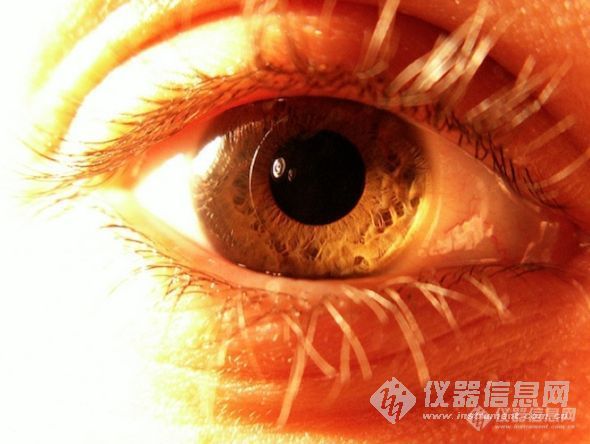
http://ng1.17img.cn/bbsfiles/images/2011/06/201106230851_301113_1618299_3.jpg隐花色素2是一种对磁场感知极为关键的蛋白质,近期在果蝇身上进行的实验得到了一个惊人的结果:人类的眼睛中含有同样功效的物质
1.增强免疫功能食品素材 主要有小球藻、螺旋藻等藻类;乳酸菌、双歧杆菌等细菌类;蘑菇多糖、担子菌等食用真菌类;黄绿色蔬菜和水果、大豆肽、芦荟等植物成分;甲壳素、蜂王浆、蜂蜡、牡蛎肉等动物成分;人参、灵芝、刺五加、虫草等传统中草药类;还有褪黑素、核酸等合成物质等。 以上这些成分按其作用机制大体可分为两大类:第一类是以p—蘑菇多糖为代表,有刺激白细胞表面膜的作用,使细胞活素生成能力增强;另一类以蔬菜中含硫化合物为代表,对白细胞内代谢有调节作用。 2.抗氧化草药及植物成分 氧化应激是癌、心脑血管病和衰老的主要原因。植物多酚是近年来国外研究最多的天然抗氧化功能食品素材。植物多酚种类繁多,主要有酚酸、原花色素、单宁、黄酮类等。目前,国外主要从以下植物成分提取多酚类物质:茶、紫苏籽和叶、芝麻、葡萄籽和叶、未熟苹果、月见草籽皮、越橘皮、大豆、桉树叶、生姜、桑叶等。 多酚类物质具有抗氧化、抗癌、抗过敏、消炎、降血脂、降血糖、抑制动脉硬化、抗衰老等多种功效。在欧洲,葡萄籽多酚早在30多年前就作为药物使用,它具有降血脂、抗氧化等多种功效,对动脉硬化、癌、糖尿病及其合并症、运动应激引起的肌肉疲劳和脂质过氧化反应均有预防效果,还可以改善肠内环境,减轻肠道排泄物的臭味。